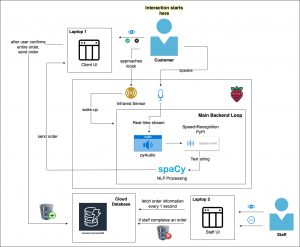Principles of Engineering, Science, and Mathematics
- Modularity – We broke our design down into smaller chunks that each manage a cohesive group of tasks. For example, the program that runs on the Raspberry Pi consists of two modules: one monitors the infrared sensor and wakes up the main backend loop; the other manages the heavy-lifting for speech parsing and recognition. These modules can further be broken down into submodules such as signal processing, speech-to-text translation, and text parsing (NLP).
- Ethicality – One of the main goals of our project is to improve the welfare of fast-food restaurant employees. We believe that the success of our system will alleviate the burden of kitchen staff, enabling them to focus only on preparing food. Our infrared sensor and ordering station will also accommodate customers in wheelchairs as well as children.
Risks
Since we are still in the design phase of our project, the most significant risk that could jeopardize its success is failing to consider important design requirements, which would lead to fundamental flaws in our design. To mitigate this risk, we will carefully review feedback from our design presentation and discuss potential problems with our instructors.
Design Changes
We finalized our design for the design review presentation and created a system diagram for the current design:

We have already requested and received a Raspberry Pi 4 with 8GB memory from the ECE inventory. Once we present our design and receive feedback, we will start ordering the hardware components (infrared sensor, microphone, and sound shield).
Schedule
We reformatted our schedule and took spring break into consideration.
Here’s the updated version:

